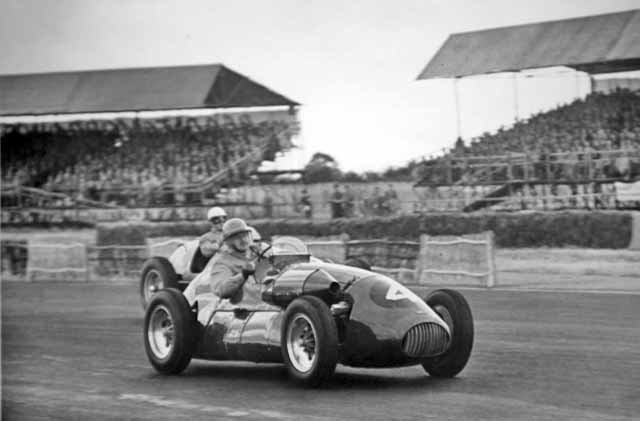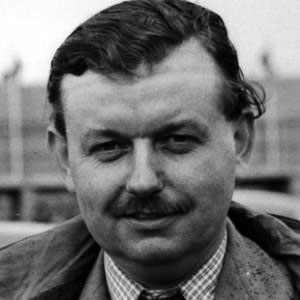Kenneth Henry Downing (5 December 1917 in Chesterton, Staffordshire – 3 May 2004 in Monte Carlo) was a racing driver from England. Downing was born into a wealthy family, whose interests included manufacturing, transport and garages. Info from Wiki
Bio by Stephen Latham
A genuine privateer who bore allegiance to the Connaught marque for most of his career, Kenneth Henry Downing made two Grand Prix starts though enjoyed success in national events. He was born on the 5th December 1917 at Chesterton, near Stoke on Trent, and his father was Chairman and founder of G.H.Downing Ltd, who produced roofing tiles, bricks and clay products. Although his father had no particular interest in motor racing, Ken became a keen racing enthusiast and his mother was a very competent driver and had been taught to drive by Perkins, who was the chauffeur and riding mechanic to Sir Henry Segrave. During the war, Ken was in France with the British expeditionary force and was there when the Dunkirk evacuations began. At one point he was surrounded by enemy soldiers but made it to Cherbourg and was able to get back to England.
His racing started after the war and his competition debut came with a Healey in 1948 on the Eastbourne Rally, where he won the novice award. He raced the Healey at the inaugural Goodwood meeting and finished second, despite being left on the grid when the clutch slipped and he found he was still in neutral. In 1949, he bought a Brooke Special from well known racer George Nixon but the Riley engine was not very competitive and he was totally outclassed. He retired from the Manx Cup, though was seventh in the Lavant Cup and eighth in the Madgwick Cup plus took third and two fourths in Goodwood Handicaps.
After switching the Riley engine for a 24 litre, 12 cylinder Delage powerplant he had an all day test at Silverstone in 1950 with it but it left most of its oil on the paddock floor. It also suffered severe oil leaks on its first outing at Gamston and the Brooke-Delage unfortunately was not a success. The car was eventually passed on to two other owners and during the late 1960s was discovered in a heated Liverpool warehouse. Ken also acquired his first Connaught in 1950, which was an early sports car, fitted with a 1.5 litre engine so he could run in the smaller class plus he stripped the body and had a new lightweight body with cycle wings. He took a third place at Silverstone, despite having to finish the race in third gear after the gear lever came off and notified his mechanics of the problem by throwing the lever to them as he passed the pits. There was also a third in class at the Gravesend Speed Trials while races with the Healey in Standard Sports and Saloons saw victories at Castle Coombe and the Gamston Handicap though he retired at Silverstone’s International Trophy.
He continued with the Connaught in 1951 and became a regular winner in club races, taking fifteen victories, including Gamston, Silverstone, Ibsley and Winfield along with many podium places. He won the sports class at the Replow Speed Trials and racing his Healey he won the Gamston Handicap and was second at Silverstone and Winfield. He was also a founder of the Cheshire Car Circuit Club, which started racing at Oulton Park, though he himself never raced there.
At the end of that year he bought a Connaught A-type 2-litre F2 car and his was the first customer car, chassis 03, and when the rules for GP racing in 1952 allowed 2-litre cars to compete, Ken suddenly found himself with a GP car. Contesting Silverstone’s International Trophy, during a heat he oiled a plug, broke the drive to the magneto and blew the head gasket but managed to start the final and finished thirteenth. He won the Madgwick Cup at Goodwood and was fourth at Boreham and a Goodwood Handicap plus set an F1 record at the Prescott hillclimb that stood for five years. He also won a Boreham sports car race in his old Connaught and was second in the Handicap and tenth in the F2 race while at Silverstone he took third in both the Allcomers and Handicap races. In early June he was in Belgium to contest his first European race, the Grand Prix de Frontieres at Chimay. He qualified fifth and on the second row though when the race was underway he was eventually leading and had a sizeable lead over the field. At one point he was ahead by forty six seconds though lost time in the rain due to a trip down an escape road and a tight spin on a narrow road. He still led on the last lap when his wife Liz displayed the pit board informing him he had a fourteen second advantage on second placed Paul Frere. Ken eased up but the fourteen-second gap was indicated for the previous lap and as he came out of the final turn, Frere’s HWM blasted past and took him at the flag. Ken had led up to the last forty metres of the race. In the following month he made his GP debut at Silverstone, which also saw three other Connaughts entered, driven by Kenneth McAlpine, Eric Thompson and Dennis Poore. It was expected to once again be a dominant display of Ferrari power and Ken qualified on the second row of the grid behind the three factory cars of Farina, Ascari and Taruffi and Manzon’s Gordini. Although his time was equalled by Reg Parnell and Mike Hawthorn, he was the first to set the time and so became the highest placed British driver on the grid. Pole sitter Farina had a lot of wheelspin off the line and Ascari pulled ahead after making a better start, though Taruffi also had a bad start and had dropped back into the midfield. Poore made an incredible start and at the end of the first lap the order was Ascari, Farina and Poore with Ken in fourth place. Farina was struggling to shake off the two Connaughts and they were making an impressive debut and keeping pace with the Ferraris. Ken was passed by Taruffi and on lap fifteen the Ferrari took third place after Poore spun after hitting an oil patch. Eventually, Poore was running third ahead of Hawthorn with Ken fifth ahead of Reg Parnell. Although the Connaughts proved quick they were struggling with fuel consumption and Ken was delayed during a poor pit stop plus also spun avoiding a back marker and dropped back to ninth place. At the finish, Ascari took a dominant win ahead of Taruffi and Hawthorn with Poore and Thompson fourth and fifth, Ken in ninth place and McAlpine sixteenth. His second GP came at Zandvoort though the Connaught struggled in the dunes against the more nimble Coopers and Gordinis and after qualifying thirteenth he retired from the race after 27 laps due to oil pressure problems.
At the end of that year he sold all his cars and bought an Aston Martin DB3 sports racing car. He contested the Silverstone International plus took a third place finish at Thruxton in May and the following month won an MMEC Silverstone race but despite qualifying in a heat he did not start at the British Empire Trophy due to brake problems. The DB3 was sold half way through the year as he decided to concentrate on his chairmanship of the family business.

Gallery F1





